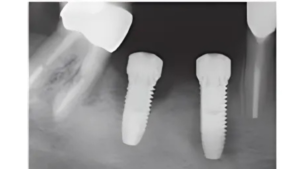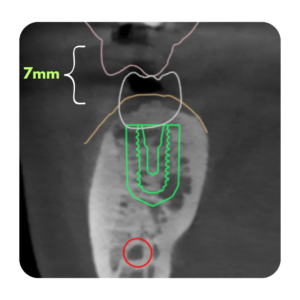On social media these days it can sometimes be hard to separate the pearls from ????. Why? Well, implant placing philosophies are as varied as the implant surfaces out there. Every company and speaker is touting their latest and greatest design. This design has lion claws. That design has a gold collar. Next thing you know, one company will come out with WIFI hotspots on their implants.
Just to help keep us grounded, let’s do a quick review on what NOT to do. Because at least we can all agree on that?
The ideal implant placement should allow the construction of a prosthetic that is cleansible, functional, and it should look pretty damn decent too–no metal showing, no overcontoured bulges. You have to assume that at every dinner party your patient is going to stick their finger in their mouth and announce, “Hey look everyone! This is an implant!”
To that announcement, you want people to gasp from amazement. Not shriek from horror. So let’s get on with it:
1.BL position
If the implant is placed too far to the buccal, you may get more bone remodeling on that buccal plate. That can lead to a tissue defect and a potentially big esthetic problem. So, to avoid that, preserve at least 2mm thickness on that buccal plate.
Now if the implant is too lingual, it can lead to an overcontoured restoration. You might end up having to do a ridge lap design just to get the cervical area to appear more natural. That will lead to an area of poor cleansability. This leads to inflammation and a subsequent descructive tissue response.
2. Vertical position
If the implant is placed too shallow, it wont allow for the adequate height of supracrestal tissue. It will also mean that you have less space to work with to develop your emergence profile. The emergence will be ridiculous and uncleansable. Finally, if you have any bone loss on a shallow implant, it will be visible!
Now, if you place too deep, there is the potential of creating an area that will harbor pathogenic bacteria. You want your tissue around the implant and abutment to be nice and healthy and form a stable collar around the abutment. But if your implant is very deep and there are hygiene concerns, it is safe to say that you wont be able to keep the abutment-implant interface very effectively at all. (According to Saleh MHA et al 2018, if you place deeper than 3mm subcrestal you might be prone to more bone remodling)
Mesiodistal
Finally, placing an implant off center has issues of it’s own. Depending on how it’s done, it can present a very unhygienic restoration as there is a big ledge that is covering the tissue space. However, some have advocated creating an embrasure right in the middle of a molar so that it is easier to clean. Another issue with mesio-distally off-center restorations is that the pontic can basically behave like a fulcrum. Without this will lead to screw loosening. At worst this can lead to fracture of the prosthetic or even fracture of the implant platform.
So, while we might not all agree on how to place implants. This little review of potential pitfalls when placing can give us a starting point for thinking critically about those beautifully placed implants we often see on our scroll wall.
I hope that helps!
Ivan Chicchon





Responses